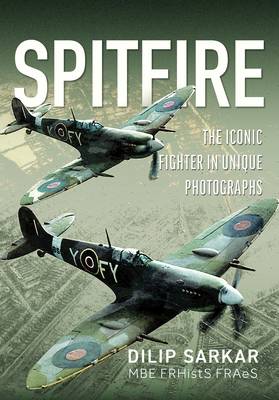
- Retrait en 2 heures
- Assortiment impressionnant
- Paiement sécurisé
- Toujours un magasin près de chez vous
- Retrait gratuit dans votre magasin Club
- 7.000.0000 titres dans notre catalogue
- Payer en toute sécurité
- Toujours un magasin près de chez vous
Spitfire
The Iconic Fighter in Unique Photographs
Dilip Sarkar Mbe Frhists Fraes
Livre relié | Anglais
30,95 €
+ 61 points
Description
A photographic history of the Supermarine Spitfire, tracing its design, global service, and lasting wartime legacy.
The Supermarine Spitfire is one of the most iconic fighters of all time. First flown just before the Second World War, interest in this remarkable aircraft endures.
Intended as a close-range interceptor, the Spitfire actually performed in roles that had never been envisaged by its designer, R.J. Mitchell. This included being operated as a long-range bomber escort fighter, fighter-bomber, night-fighter, or photographic reconnaissance aircraft; there was even a naval version, the Seafire, that was flown from aircraft carriers.
The Spitfire flew and fought on every front, in every theatre - even on the Eastern Front where examples of the Mk.Vb, supplied to the Russians under Lend-Lease, were operated by the Soviet Air Force. The battle honours that could be applied to the Spitfire cover every major battle and campaign of the Second World War, from the Battle of Britain to the fighting in the Western Desert and jungles of Burma. Furthermore, the Spitfire was operated by many other countries, including the United States. Developed through twenty-four variants, the Spitfire remained in service with many air forces long after 1945. Little wonder, then, that the fascination in R.J. Mitchell's little fighter is not only durable, but global.
Countless photographs have been taken of the Spitfire, including innumerable high-quality press photographs. During the Second World War, however, private photography on service installations was prohibited - but, nevertheless, some personnel, aircrew and groundcrew alike, took furtive snapshots. Forming the basis of this book, these amateur images providing us with an authentic and candid window on the past. Drawing on a unique collection of rare archive images, the renowned aviation historian Dilip Sarkar MBE, RHistS, FRAeS, explores the history of the Spitfire from its inception and first flight in 1936, through its introduction to service and then its service to the Allied nations throughout the Second World War.
The Supermarine Spitfire is one of the most iconic fighters of all time. First flown just before the Second World War, interest in this remarkable aircraft endures.
Intended as a close-range interceptor, the Spitfire actually performed in roles that had never been envisaged by its designer, R.J. Mitchell. This included being operated as a long-range bomber escort fighter, fighter-bomber, night-fighter, or photographic reconnaissance aircraft; there was even a naval version, the Seafire, that was flown from aircraft carriers.
The Spitfire flew and fought on every front, in every theatre - even on the Eastern Front where examples of the Mk.Vb, supplied to the Russians under Lend-Lease, were operated by the Soviet Air Force. The battle honours that could be applied to the Spitfire cover every major battle and campaign of the Second World War, from the Battle of Britain to the fighting in the Western Desert and jungles of Burma. Furthermore, the Spitfire was operated by many other countries, including the United States. Developed through twenty-four variants, the Spitfire remained in service with many air forces long after 1945. Little wonder, then, that the fascination in R.J. Mitchell's little fighter is not only durable, but global.
Countless photographs have been taken of the Spitfire, including innumerable high-quality press photographs. During the Second World War, however, private photography on service installations was prohibited - but, nevertheless, some personnel, aircrew and groundcrew alike, took furtive snapshots. Forming the basis of this book, these amateur images providing us with an authentic and candid window on the past. Drawing on a unique collection of rare archive images, the renowned aviation historian Dilip Sarkar MBE, RHistS, FRAeS, explores the history of the Spitfire from its inception and first flight in 1936, through its introduction to service and then its service to the Allied nations throughout the Second World War.
Spécifications
Parties prenantes
- Auteur(s) :
- Editeur:
Contenu
- Nombre de pages :
- 224
- Langue:
- Anglais
Caractéristiques
- EAN:
- 9781036146917
- Date de parution :
- 06-01-26
- Format:
- Livre relié
- Format numérique:
- Genaaid
- Dimensions :
- 171 mm x 248 mm
- Poids :
- 592 g

Seulement chez Librairie Club
+ 61 points sur votre carte client de Librairie Club
Les avis
Nous publions uniquement les avis qui respectent les conditions requises. Consultez nos conditions pour les avis.






